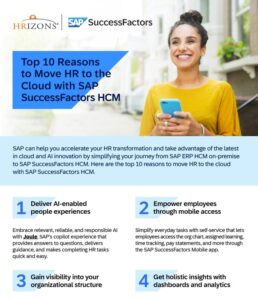I recently presented at the LEHRN Minnesota HR Tech Expo in Minneapolis on Integrated Human Capital Management (IHCM) as the next step for HR to move beyond process automation and towards strategic HR. In this blog, I want to share some of the key topics and audience reactions from the session that relate to who we are at HRIZONS and our strategy toward HR. Before we begin, I think it’s important to define what IHCM means:
Integration of HR and talent content, processes, systems, and information to ensure that organizations have the right people in the right place, at the right time, at the right cost.
HR really needs to have a vision and holistic view of how it can become a value-adding and strategic people organization. That vision has to encompass a number of building blocks to represent the journey from automation to strategic HR. The model below showcases how the right technology infrastructure serves as the enabler for true process, systems and content integration and ultimately provides the platform to help the organization align the workforce and govern to be a strategic business partner that helps the organization execute its strategy and achieve its vision.
In order to achieve this vision and create the building blocks, the right approach is required. I believe that a 4-lenses approach is the best enabler:
- The right process design that drives efficiency, effectiveness, integration and role clarity
- The right job and competency content that scales to support all your talent management processes
- The right integrated technology platform to leverage talent content and data and drive better execution
- The right analytics to support informed talent decision-making across the enterprise
Wrap that with the proper governance and this construct is no longer a fantasy, but rather an achievable reality.
It was quite interesting when I directed a question at the audience asking “Who has an HR Technology initiative in place towards deploying an integrated HCM Suite?” About 30% of the audience responded, which tells me that many organizations are still managing non-automated, non-integrated HR processes and activities. On a follow-up, it seems apparent that many organizations are still using spreadsheets-based “systems” for HR and are clearly operating in silos that address specific use-cases vs. holistic enterprise wide organizational people needs.
However, the simple reality is that process, content, and systems integration is a challenging exercise and requires more than just knowing your HR processes – you need to fully understand the fundamental building blocks that drive these processes and the infrastructure required to properly enable it. A simple example of one of the core building blocks is job profiles and competencies which encompass skills, behaviors, and other KSOACS (Knowledge Skills Abilities and Other Characteristics) required to effectively drive a business at different levels. Without good job profiles that define what’s required and expected from each position, it’s very difficult to do much more than automate processes.
Demonstrating IHCM
In order to demonstrate how IHCM could work, I presented a short story: “A Day in the Lifecycle: Life Before & After IHCM”. I used pairs of slides to show how HR looks in most organizations today as a current state and how it can look after IHCM as the future state. Below you can see Self-Services current state and then future state:
And Compensation Management current state and future state:
The Facts
Although this is a good way of showing the people outcomes of IHCM, the most effective measurement are the statistics. The Bersin 2009 Talent Management Factbook states that “Revenue per employee is 26% higher in companies with an Integrated Talent Management strategy”. Organizations that are fully integrated have significantly higher effectiveness in developing employees with the right skills, improving employee productivity, placing people into the right jobs, and retaining top performers among other key HR KPIs. The biggest being employee engagement and how that affects an organization’s performance.
Key Lessons Learned
I have been doing this for a long time, since I was a VP of HR myself. The key lessons I have learned over my time are:
- Get HR in the Driver’s Seat
- IHCM is a Journey… that Needs Direction, Investment, and Governance
- Know Your Organization’s Readiness, Complexities, and Fill the Gaps
- IHCM Needs Silo Busting… a holistic view of the organization and HR
By defining a world-class IHCM strategy and implementing the right integrated technology platform, any organization can become a more effective organization that better leverages its most important differentiator and asset – its’ people! As the pressure grows on many businesses to do more than just survive, isn’t it time you leveraged an IHCM strategy to help your organization thrive? Get HR in the Driver’s Seat and contact HRIZONS today!








